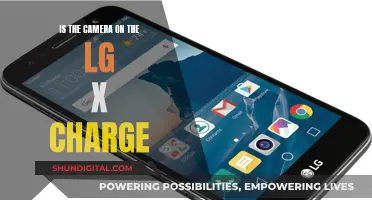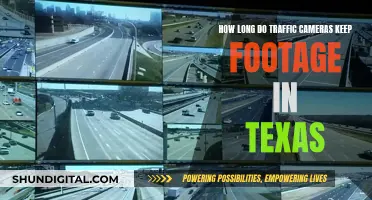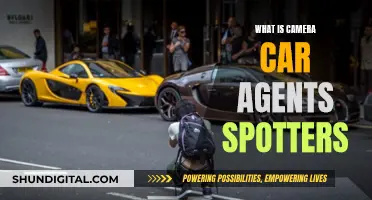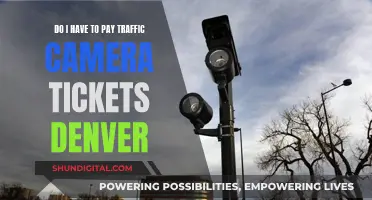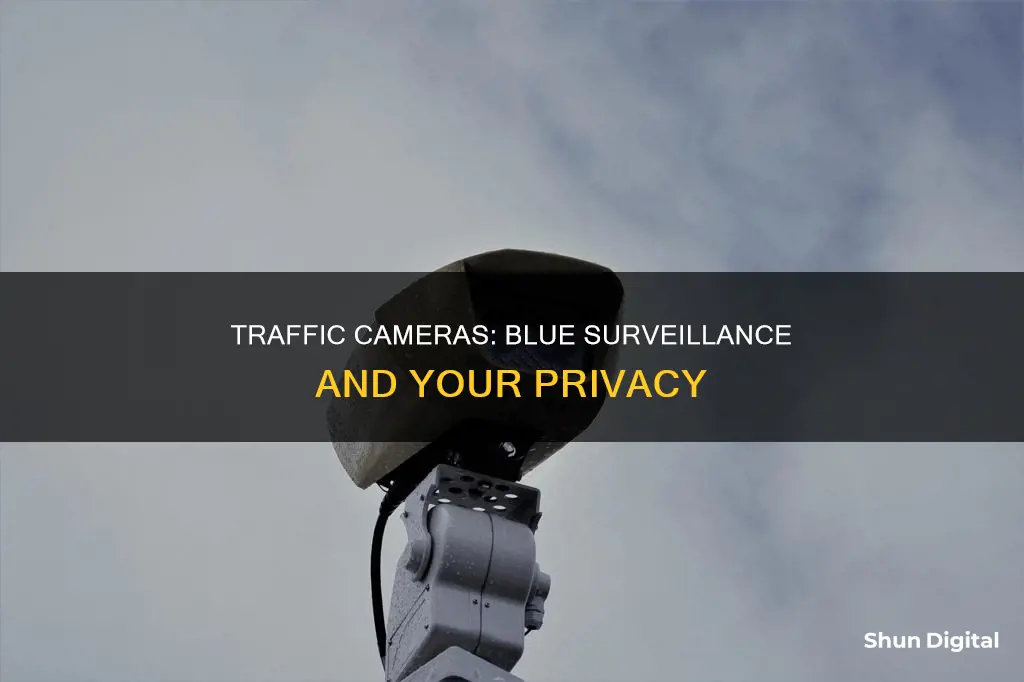
Blue traffic cameras are roadside devices that monitor traffic speeds and congestion levels. They are not speed cameras, but part of a road-monitoring network operated by a company called Trafficmaster. There are 7,500 such sensors on major roads and motorways, and they gather real-time traffic data to sell to clients such as haulage operators and transport companies. The data helps keep their fleets moving efficiently and on time. These cameras are not designed to record individuals but to detect traffic.
| Characteristics | Values |
|---|---|
| Purpose | Monitoring traffic density and speeds |
| Operator | Trafficmaster |
| Number of Sensors | 7500 |
| Sensor Locations | Major roads and motorways |
| Data Use | Sold to clients such as haulage operators and transport companies |
| Data Use | Helping clients keep their fleets moving efficiently and on time |
What You'll Learn

Blue traffic cameras are not speed cameras
While some people believe that these cameras monitor traffic speeds, they are actually used to monitor traffic density and look for traffic jams. They do this by capturing the central part of a car's number plate and measuring how long it takes to get to the next blue camera. This data is then sold to companies to help them avoid traffic.
Police could get a court order to force TrafficMaster to hand over data, but they would be unlikely to do so for speeding offences.
Point-and-Shoot Cameras: Can They Shoot RAW?
You may want to see also

They monitor traffic density and congestion
Blue traffic cameras are part of a road-monitoring network operated by Trafficmaster. There are 7500 such sensors on major roads and motorways in the UK. They monitor traffic density and congestion by gathering real-time traffic data and selling it to clients such as haulage operators and transport companies. This helps them keep their fleets moving efficiently and on time.
These blue devices are mounted on roadside poles and face both ways on most A roads. They are not speed cameras, but they do measure speed in some cases by capturing the central part of a car's number plate and measuring how long it takes to get to the next blue camera. However, their main purpose is to monitor traffic density and look for traffic jams.
Trafficmaster provides information to drivers whose satellite navigation systems have Trafficmaster built-in, including popular sat-nav brands such as Garmin and Magellan. This helps the sat-nav to avoid jams. While police could get a court order to force Trafficmaster to hand over data, they are unlikely to do so for speeding offences.
The First Camera: Joseph Niépce's Invention
You may want to see also

They are operated by a company called Trafficmaster
Blue traffic cameras are not speed cameras. They are operated by a company called Trafficmaster and are part of a road-monitoring network. There are 7500 such sensors on major roads and motorways across the country. They are mounted on roadside poles and face both ways.
Trafficmaster cameras gather real-time traffic data and sell it to clients such as haulage operators and transport companies. This helps them to keep their fleets moving efficiently and on time. The cameras monitor traffic speeds and congestion levels. This information is sent to drivers whose satellite navigation systems have TrafficMaster built-in, including popular sat-nav brands such as Garmin and Magellan. This helps the sat-nav to avoid jams.
Police could get a court order to force TrafficMaster to hand over data, but they would be unlikely to do so for speeding offences.
Who Manufactured Falling Plate Cameras?
You may want to see also

They are placed 10 feet high and face both ways on most A roads
Blue traffic cameras are not speed cameras. They are part of a road-monitoring network operated by Trafficmaster. These cameras are placed 10 feet high and face both ways on most A roads. They are mounted on roadside poles and gather real-time traffic data. The data is then sold to clients such as haulage operators and transport companies to help keep their fleets moving efficiently and on time.
The cameras are placed 10 feet high so that they can monitor traffic in both directions. This height allows them to capture clear images of the vehicles and the road conditions. By facing both ways, the cameras can track the flow of traffic and provide valuable data on traffic patterns and congestion.
The placement of the cameras at a height of 10 feet also ensures that they are visible to motorists. This visibility can serve as a reminder to drivers to obey traffic laws and regulations. Additionally, the cameras' presence can help deter traffic violations and encourage safer driving habits.
The height and positioning of the cameras are carefully considered to ensure optimal data collection and coverage. The 10-foot height provides a comprehensive view of the road, capturing multiple lanes and allowing the cameras to monitor a significant stretch of the roadway. This strategic placement contributes to the effectiveness of the road-monitoring network.
It is important to note that the blue traffic cameras are not intended to replace human officers. Their primary purpose is to monitor traffic flow and provide data that can be utilised to improve traffic management and road safety. The data collected by these cameras can help identify areas of congestion, frequent traffic jams, or high-density traffic areas. This information can then be used to optimise traffic signal timing, implement traffic management strategies, or plan road infrastructure improvements.
Sigma Dealer Focus Camera: Certified and Trustworthy
You may want to see also

They gather real-time traffic data and sell it to clients
Blue traffic cameras are not speed cameras. They are part of a road-monitoring network operated by a company called Trafficmaster. There are 7500 such sensors on major roads and motorways, and they gather real-time traffic data. This data is then sold to clients such as haulage operators and transport companies, who use it to help keep their fleets moving efficiently and on time.
The cameras are placed about 10 feet high and face both ways on most A roads. They monitor traffic speeds and congestion levels, and this information is sent to drivers whose satellite navigation systems have TrafficMaster built in. This helps the sat-nav to avoid jams.
While police could get a court order to force TrafficMaster to hand over data, they are unlikely to do so for speeding offences. Instead, the cameras are used to monitor traffic density and look for traffic jams, rather than individual vehicles' speeds.
TrafficMaster's cameras are distinct from other types of traffic cameras, such as Gatso, Truvelo, and Hadecs3, which are used to catch speeding drivers and issue fines.
Canadian Police Cars: Are On-Board Cameras Standard?
You may want to see also
Frequently asked questions
Blue traffic cameras are roadside devices that monitor traffic speeds and congestion levels. They are not speed cameras.
Blue traffic cameras are located on major roads and motorways. They are placed 10 feet high and face both ways.
Blue traffic cameras are operated by a company called Trafficmaster.
Trafficmaster sells the data to clients such as haulage operators and transport companies to help keep their fleets moving efficiently and on time.



